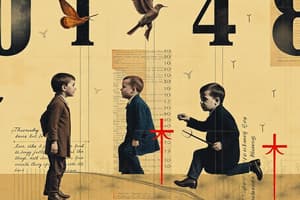Podcast
Questions and Answers
Children from 1 month to 1 year of age are called ________.
Children from 1 month to 1 year of age are called ________.
Infants
What is the normal pulse rate for an infant?
What is the normal pulse rate for an infant?
100-160 bpm
Infants often fall head first because ___________.
Infants often fall head first because ___________.
their head is large and heavy in proportion to their body
_____________ is a critical stage in the development of conscience-based decision making.
_____________ is a critical stage in the development of conscience-based decision making.
Secondary sexual development occurs during__________________.
Secondary sexual development occurs during__________________.
High-risk behaviors usually peak during ________.
High-risk behaviors usually peak during ________.
Many effects of aging can be diminished by_____________.
Many effects of aging can be diminished by_____________.
Age-related shrinkage of the brain increases the risk of__________.
Age-related shrinkage of the brain increases the risk of__________.
Which of the following statements regarding toddlers and preschoolers is correct?
Which of the following statements regarding toddlers and preschoolers is correct?
The pulse rate of a child from ages 6 to 12 years is approximately:
The pulse rate of a child from ages 6 to 12 years is approximately:
Which of the following statements regarding psychosocial development in the adolescent age group is correct?
Which of the following statements regarding psychosocial development in the adolescent age group is correct?
The low normal systolic blood pressure for a 30-year-old is:
The low normal systolic blood pressure for a 30-year-old is:
Which of the following statements regarding middle adults is correct?
Which of the following statements regarding middle adults is correct?
At present, the average life expectancy is ___________ years, while the maximum life expectancy is estimated at __________ years.
At present, the average life expectancy is ___________ years, while the maximum life expectancy is estimated at __________ years.
When assessing and treating an injured 75-year-old patient, what must you recall?
When assessing and treating an injured 75-year-old patient, what must you recall?
Breathing is often more difficult in older adults because the:
Breathing is often more difficult in older adults because the:
Which of the following statements regarding age-related changes in the nervous system is correct?
Which of the following statements regarding age-related changes in the nervous system is correct?
Which of the following is an anatomical difference between children and adults?
Which of the following is an anatomical difference between children and adults?
In contrast to secure attachment, anxious-avoidant attachment occurs when a child:
In contrast to secure attachment, anxious-avoidant attachment occurs when a child:
Flashcards are hidden until you start studying
Study Notes
Infant Development
- Infants are defined as children from 1 month to 1 year old.
- Normal pulse rate for infants ranges from 100 to 160 bpm.
- Infants tend to fall headfirst due to the larger size and weight of their heads compared to their bodies.
Childhood Stages
- School age is crucial for developing conscience-based decision-making.
- Toddler and preschoolers typically experience upper respiratory infections due to the loss of passive immunity.
Adolescence
- Secondary sexual development occurs during adolescence.
- High-risk behaviors peak during adolescence.
- Antisocial behavior and peer pressure are most prevalent between 14 and 16 years old.
Adult Development
- Regular exercise can mitigate many age-related effects.
- Brain shrinkage with age increases the risk of brain injury.
- Cardiovascular health issues and cancer become common concerns for middle adults.
Life Expectancy
- Average life expectancy is around 78 years, with a maximum potential of about 120 years.
Physiological Changes in Older Adults
- A 75-year-old may have impaired physiological compensation for injuries due to decreased cardiac output capacity.
- Breathing difficulties in older adults arise because of reduced lung elasticity.
Nervous System Changes
- Interconnections between brain cells can help maintain knowledge and skills, despite neuron loss as one ages.
- The metabolic rate in the brain increases with age, despite lower oxygen consumption.
Anatomical Differences in Children
- An infant's tongue is proportionally larger than that of an adult, affecting airway management.
- In children, differences include rib cage flexibility and trachea length compared to adults.
Attachment Styles
- Anxious-avoidant attachment in children signifies minimal emotional response or engagement with caregivers.
Studying That Suits You
Use AI to generate personalized quizzes and flashcards to suit your learning preferences.




